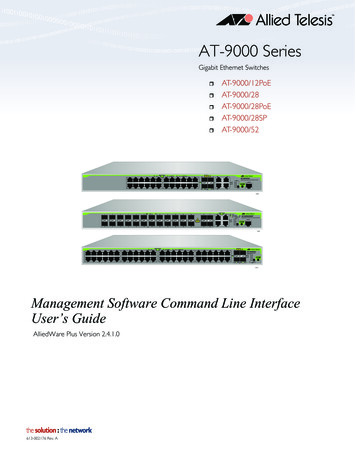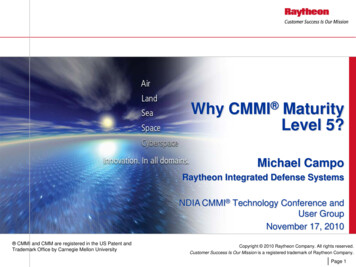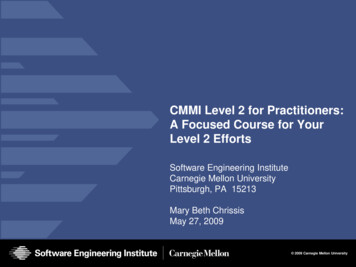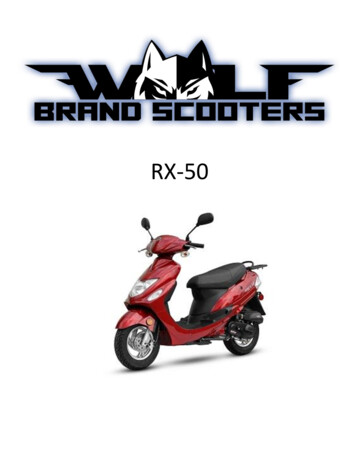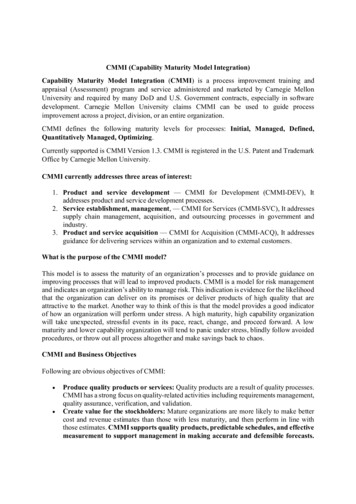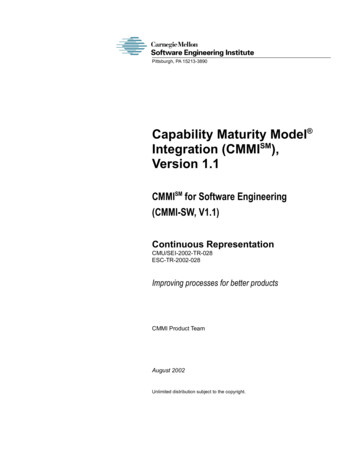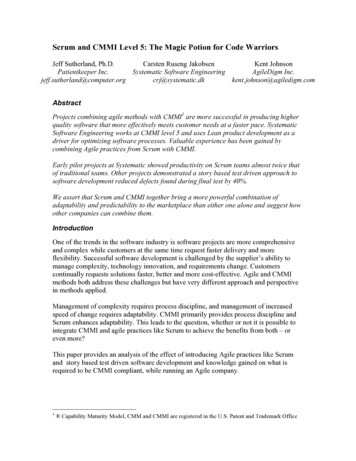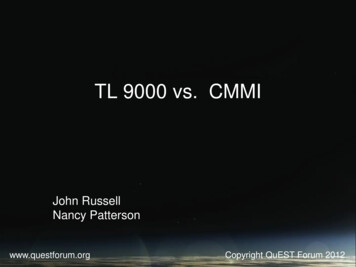
Transcription
TL 9000 vs. CMMIJohn RussellNancy Pattersonwww.questforum.orgCopyright QuEST Forum 2012
CMMI to TL 9000 Mapping SubteamMembers: John Russell Nancy Patterson Ed Bryan Aniket Deshpande Lakshminarayanan Rangaswamy Balamurugan Arunachalam Christine FerraraSME: SM Balasubramaniyan & WIPRO Engineers
What is it and Where is it? Maps TL 9000 V5.0 Requirements to theCMMI-DEV v1.3 Maturity Level 2 & 3Process Areas Posted to QuEST Forum Member’s Areafor member access
What is CMMI? CMMI (Capability Maturity Model Integration) isa proven industry model of best practices– Improves Quality through process improvement & behavior change– Leads to development & maintenance efficiency improvement– Improves customer satisfaction, time to market, & businessprofitability
What is CMMI? CMMI provides a direction in terms of what youneed to do & measure, but does not tell youhow to do it Developed by a consortium of industry,government and research experts led by theSoftware Engineering Institute at CarnegieMellon University
CMMI Staged Representation:Five Maturity Levels:5OptimizingFocus on processimprovement4Process measuredand controlled3Processcharacterized for theorganization and ocess characterizedfor projects and isoften reactiveProcess unpredictable,poorly controlled, andreactiveJudah Mogilensky, PEP, Inc. Oct 2003Initial
CMMI Model Component CategoriesMaturity LevelsProcess Area 1RequiredProcess Area 2SpecificGoalsProcess Area nGenericGoalsCommonCommitmentto PerformSpecificPracticesAbilityto PerformExpected ExpectedSubpractices, typical work products,discipline amplifications, genericpractice elaborations, goal and practicetitles, goal and practice notes, ces, typical work products,discipline amplifications, genericpractice elaborations, goal and practicetitles, goal and practice notes, andreferencesAdapted from Judah Mogilensky, PEP, Inc who adapted it from a chart created by the SoftwareEngineering Institute, Carnegie Mellon University
Reference Model Scope –CMMI - DEV V1.3 (Staged)FocusProcess Areas5 al Performance ManagementCausal Analysis and Resolution4 ational Process PerformanceQuantitative Project ManagementLevel3 Defined2 Managed1 tQuality &ProductivityRequirements DevelopmentTechnical SolutionProduct IntegrationVerificationValidationOrganizational Process FocusOrganizational Process Definition IPPDOrganizational TrainingIntegrated Project Management for IPPDRisk ManagementDecision Analysis and ResolutionRequirements ManagementProject PlanningProject Monitoring and ControlSupplier Agreement ManagementMeasurement and AnalysisProcess and Product Quality AssuranceConfiguration ManagementRisk &Rework
What is TL ommon TL 9000 rvicesCommon TL 9000 RequirementsInternational Standard ISO 9001Based on ISOTL9000
ISO/TL 9000 vs. CMMI The TL 9000 model specifies detailedimplementations as requirements CMMI requires that goals be met, expectsthat practices related to those goals areimplemented, and provides suggestionsfor detailed implementation of thepractices as informative, not required,material
ISO 9001 / TL 9000 Example7.2.1 Determination of Requirements Related to the Product:– The organization shall determinea) requirements specified by the customer, including the requirements fordelivery and post-delivery activities,b) requirements not stated by the customer but necessary for specified orintended use, where known,c) statutory and regulatory requirements applicable to the product, andd) any additional requirements considered necessary by the organization. 7.2.2.C.1 Closure Tracking– All actions resulting from requirements reviews shall be tracked to closure.CMMI-SE/SW Requirements Development Practice Area:– SG1 Stakeholder needs, expectations, constraints, and interfaces are collectedand translated into customer requirements– SP3.3 Analyze requirements to ensure that they are necessary and sufficient– SP3.4 Analyze requirements to balance stakeholder needs and constraints– SP3.5 Validate requirements to ensure the resulting product will perform asintended in the user's environment using multiple techniques as appropriate
ComparisonISO/TL 9000CMMITL 9000 adds specific telecom product CMMI describes generic bestand service requirements to the more practices for creating products andgeneric practices specified by ISOservices in any domain9001:2008TL focuses on pre-deploymentdevelopment and delivery, with postdeployment metricsCMMI focuses primarily on predeployment best practices andmeasurement capabilitiesTL 9000 gives specific instructions for CMMI expects the organization tocustomer involvement as stakeholders identify and involve relevantstakeholders, but does not specifywho they should beIn an ISO/TL audit, you must showhow the organization fulfills therequirementIn CMMI assessment, you mustdemonstrate how the organizationmeets the goals and specific practicesif they are applicable
The Bottom Line CMMI L3 Appraised software organizationwill meet ISO 9001/TL 9000 requirementswith gaps in the following areas:-Post deployment supportCustomer satisfaction surveysQuality partneringDisaster Recovery TL 9000 hardware (H) adders are notaddressed in CMMI Doesn’t count metrics
Mapping ExampleISO9001:2008TL 9000 SummaryREQM SG1All actionsresultingfromrequirementsreviews shallbe tracked toclosure.Met by REQM SG1, M SP 1.5-1(Implied inRD SG3 and VERsub practiceSG2; also supported4) (from aby GG2 for REQM,designRD and VERperspective)REQMGG2x
SM(SCAMPICMMIAppraisalsA*) Appraisal results are provided by an accredited SCAMPI LeadAppraiserSM Appraisal results are a snapshot of organization process maturity Appraisals are “verification-based” rather than “discovery-based” Team size varies usually 4 to 8 team members involving a readinessreview usually 2 weeks and an appraisal usually 2 weeks 100% of the practices in every process area relevant to a maturitylevel are evaluated in a SCAMPI appraisal 100% of the practices in every representative project are evaluatedin a SCAMPI appraisalSMSCAMPI and SCAMPI Lead Appraiser are service marks of Carnegie MellonUniversity* SCAMPI - Standard CMMI Appraisal Method for Process Improvement
Measurement & AnalysisProcess Example The purpose of the process area is to develop and sustain a measurementcapability that is used to support management information needs.It all begins with an organizational policy for planning and performing themeasurement and analysis process. (supports generic goal to institutionalizea process)The two specific goals of this process are (1) to align measurementobjectives and activities with identified information needs and objectives and(2) provide measurement results that address information needs. Thesespecific goals are supported by relevant specific practicesA generic goal of this process within the model is institutionalizing theMeasurement and Analysis process. This generic goal is supported byrelevant generic practices.In order to do the alignment you need to first derive measurement objectivesfrom identified information needs and then specify the measures to meet theobjectives, how they will be collected, stored, analyzed and reported.Finally, you execute on the collection, storage, analysis and reporting youhave defined.Note, your own business needs drives the specific mechanisms for satisfyingthe practices and goals, not a specific CMMI requirement.
Questions?
Best Practice ConferencesAmericas Best Practices Conference10 – 12 September 2012Chicago, Illinois, USA19
Face to Face WorkgroupMeetingsWorkgroups – OSWG, GBE and IGQ13 – 14 September 2012Chicago, ILWorkgroups – OSWG, GBE and IGQ13 – 16 November 2012Atlanta, GA20
Thanks for attending!Member Education Webinar Sub-TeamJennifer SimcoxMelba HillSheronda JeffriesJoan LynnTom Yohe21
ISO/TL9000 CMMI TL 9000 adds specific telecom product and service requirements to the more generic practices specified by ISO 9001:2008 CMMI describes generic best practices for creating products and services in any domain TL focuses on pre-deployment development and delivery, with post-deployment metrics CMMI focuses primarily on pre-
